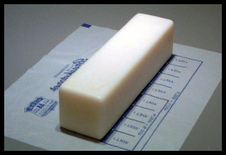Facts About Trans Fats
Some people are confused as to what trans fats are. I thought I'd post some info and links about them to clear up a few of the questions most of us have on the subject... Wondering how trans fat ended up with its own special place on food labels? Most of us grew up eating foods containing trans fat without knowing it was there. Before trans fat was added to labels in 2006, you could only recognize it under its alias, “partially hydrogenated oil,” on the list of ingredients.
Wondering how trans fat ended up with its own special place on food labels? Most of us grew up eating foods containing trans fat without knowing it was there. Before trans fat was added to labels in 2006, you could only recognize it under its alias, “partially hydrogenated oil,” on the list of ingredients.
Trans fat became popular with consumers and food manufacturers because it acted as a preservative, giving foods a longer shelf life. It also gave foods a more tempting taste and texture.
But there’s a downside to trans fat. We now know that trans fat is harmful to our health. But this knowledge is relatively new. Before 1990, some researchers suspected that partially hydrogenated oils were “bad fats,” but it wasn’t until the 1990s that research began to prove it.
What are trans fats?
Trans fats (or trans fatty acids) are created in an industrial process that adds hydrogen to liquid vegetable oils to make them more solid. Another name for trans fats is “partially hydrogenated oils." Look for them on the ingredient list on food packages.
What foods contain trans fats?
Trans fats can be found in many foods – but especially in fried foods like French fries and doughnuts, and baked goods including pastries, pie crusts, biscuits, pizza dough, cookies, crackers, and stick margarines and shortenings. You can determine the amount of trans fats in a particular packaged food by looking at the Nutrition Facts label. You can also spot trans fats by reading ingredient lists and looking for the ingredients referred to as “partially hydrogenated oils.”
How much trans fat can I eat a day?
The American Heart Association recommends limiting the amount of trans fats you eat to less than 1 percent of your total daily calories. That means if you need 2,000 calories a day, no more than 20 of those calories should come from trans fats. That’s less than 2 grams of trans fats a day. Given the amount of naturally occurring trans fats you probably eat every day, this leaves virtually no room at all for industrially manufactured trans fats. Find out your personal daily fat limits on My Fats Translator.
How can I stay within my daily limit for trans fats?
Read the Nutrition Facts label on foods you buy at the store and, when eating out, ask what kind of oil foods are cooked in. Replace the trans fats in your diet with monounsaturated or polyunsaturated fats. For practical tips, learn how to Live Fat-Sensibly.
This info and more can be found at The American Heart Association website.



3 comments:
Hi there,
I found your blog through someone else's who mentioned you. I am currently visiting your webpage! I look forward to reading more from you!!!
I could do with a lot less trans fats in my life
Congrats on the superb weight loss last week!
Post a Comment